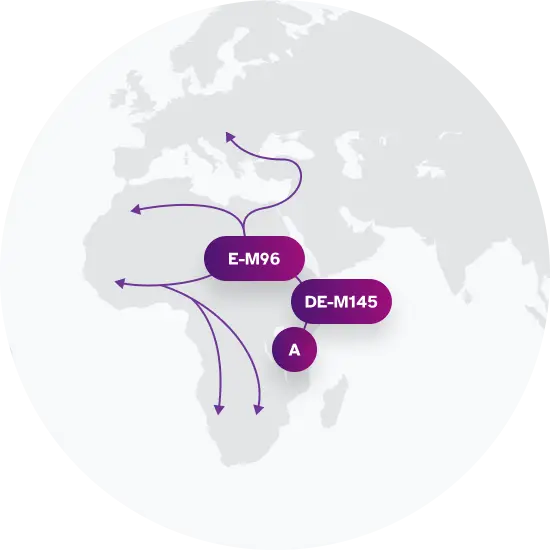Haplogroup E-V257
What is Paternal Haplogroup E-V257?
Haplogroup E-V257, also known as Haplogroup E-M96 (Y Chromosome Consortium long-form label), is a genealogical group of lineages defined by unique genetic markers present on the Y-chromosome. Your paternal haplogroup, or that of your father if you do not have a Y-chromosome, paints a picture of your ancient origins and the migrations of your ancestors. Although your paternal haplogroup reflects just one of your many ancestral lineages, it carries information about that lineage over tens of thousands of years.
Haplogroup E-V257 is descended from haplogroup E-M96. Among 23andMe research participants, haplogroup E-V257 is commonly found among populations in the United Kingdom and Ireland.
It's important to note that your haplogroup doesn't define your current ethnic identity; rather, it provides an insight into your deep ancestry on the paternal side.
 Paternal Haplogroup Origins E-M96
Paternal Haplogroup Origins E-M96Top Surnames with Haplogroup E-V257
For surnames with sufficient representation in the data, these percentages represent the frequency with which each surname is found in individuals exhibiting this genetic marker.
Haplogroup E-V257 is linked to early Spanish migrants
Many members of haplogroup E1b1b1b1 have been found in Spain. There are several possible explanations for haplogroup E1b1b1b1's presence in this area. One possibility is that Berber troops belonging to E-V257 were migrating during the Islamic expansion into the Iberian Peninsula in 711 AD. A second possibility is that North African people were migrating to the Iberian Peninsula before the founding of Islam, perhaps driven by Roman and Phoenician commerce that involved Northwest Africa and Iberia.

